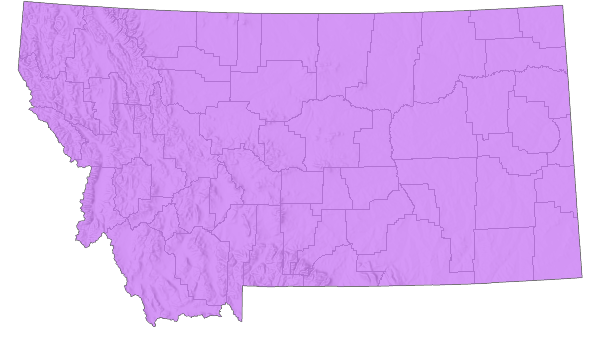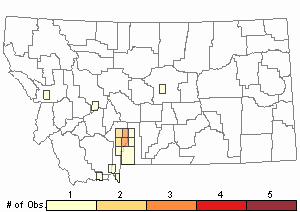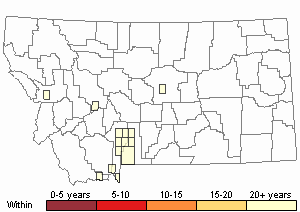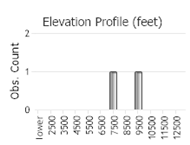View in other NatureServe Network Field Guides
NatureServe
Montana
Utah
Wyoming
Idaho
Wisconsin
British Columbia
South Carolina
Yukon
California
New York
Bruner's Spur-throat Grasshopper - Melanoplus bruneri
General Description
The following is taken from Vickery and Kevan (1985), Pfadt (2002), Capinera et al. (2004), and Scott (2010). A pale to dark brown, medium sized grasshopper with wings that reach or exceed the apex (knee) of the hind femur by 1 to 3 mm. The hind tibia is usually pink or red, sometimes greenish-yellow.
Phenology
The following comes from Hebard (1928), Vickery and Kevan (1985), Pfadt (2002), and Scott (2010).This species overwinters in the egg stage. Each egg pod contains 21 to 22 eggs. It is an early hatching species, with nymphs appearing in early June that can be delayed by a cold spring. In mountain meadows, the eggs require 2 years to hatch, and some may require 3 years at higher altitudes. Adults appear from early July to early October, reaching peak abundance in August.
Diagnostic Characteristics
Males range in body size from 18-22 mm and females 22-29 mm. The morphological features of the male genitalia and aedeagus are the major diagnostic characters to examine under magnification—10X+ (Vickery and Kevan 1985, Pfadt 2002, Capinera et al. 2004, and Scott 2010).
Can be confused with any number of Melanoplus species. Be sure to collect males for genitalia comparisons to make positive identifications, especially in habitats and geographical areas where “look-a-likes” occur together (Scott 2010).
Species Range
Montana Range
Range Descriptions

 Native
Native
Range Comments
The Bruner's Spur-thoat ranges widely from east to west across the northern latitudes of North America, occurring from Alaska to Quebec and northern Maine, southward in the west to northern Arizona and New Mexico. In Montana, this species has been confirmed in 19 counties, most of which are mountainous (Hebard 1928, Vickery and Kevan 1985, Pfadt 2002, and Scott 2010).
Observations in Montana Natural Heritage Program Database
Number of Observations: 21
(Click on the following maps and charts to see full sized version)
Map Help and Descriptions
Relative Density

Recency



 (Observations spanning multiple months or years are excluded from time charts)
(Observations spanning multiple months or years are excluded from time charts)
Habitat
This species inhabits a wide diversity of habitat types including forested areas, grassy mountain slopes, mountain meadows, prairie/rangelands where shrubs are common, the grass-herb undergrowth of quaking aspen groves, and even Arctic tundra (Hebard 1928, Vickery and Kevan 1985, Pfadt 2002, and Scott 2010).
Food Habits
The following is taken from Vickery and Kevan (1985) and Pfadt (2002). The Bruner's Spur-throat feeds on a great diversity of plants within the numerous habitats it inhabits. It prefers certain forbs, but also feeds on rangeland grasses. Its food-focus varies with seasonal changes and changes with the advance of summer. It seems to never go hungry! Example: One study in the Big Horn Mountains of Montana indicated that this species consumed 68% forbs, 21% grasses, 7% mosses, 3% fungus, and 1% pollen.
Reproductive Characteristics
No information is available as to where and how females deposit eggs. The nymphs pass through 5 instar stages to adulthood (Vickery and Kevan 1985, Pfadt 2002).
Management
The species is prone to periodic “outbreaks” with high-density populations depleting native host plants, rangeland grasses, alfalfa, and clover (Pfadt 2002).
Stewardship Responsibility
References
- Literature Cited AboveLegend:
 View Online Publication
View Online Publication Capinera, J.L., R.D. Scott, and T.J. Walker. 2004. Field Guide to Grasshoppers, Katydids, and Crickets of the United States. Ithaca, NY. Cornell University Press.
Capinera, J.L., R.D. Scott, and T.J. Walker. 2004. Field Guide to Grasshoppers, Katydids, and Crickets of the United States. Ithaca, NY. Cornell University Press. Hebard, M. 1928. The Orthoptera of Montana. Proceedings of the Academy of Natural Sciences of Philadelphia, Vol. 80:211-306.
Hebard, M. 1928. The Orthoptera of Montana. Proceedings of the Academy of Natural Sciences of Philadelphia, Vol. 80:211-306. Pfadt, R.E. 2002. Field Guide to Common Western Grasshoppers, 3rd edition. Laramie, WY: Wyoming Agricultural Experiment Station, Bulletin 912, modified by S. Schell and S. Schell for electronic publication. Accessed 19 February 2020. http://www.uwyo.edu/entomology/grasshoppers/field-guide/index.html#fieldguidetoc
Pfadt, R.E. 2002. Field Guide to Common Western Grasshoppers, 3rd edition. Laramie, WY: Wyoming Agricultural Experiment Station, Bulletin 912, modified by S. Schell and S. Schell for electronic publication. Accessed 19 February 2020. http://www.uwyo.edu/entomology/grasshoppers/field-guide/index.html#fieldguidetoc Scott, R.D. 2010. Montana Grasshoppers, Katydids, and Crickets A Pictorial Field Guide to the Orthoptera. MagpieMTGraphics, Billings, MT.
Scott, R.D. 2010. Montana Grasshoppers, Katydids, and Crickets A Pictorial Field Guide to the Orthoptera. MagpieMTGraphics, Billings, MT. Vickery, V. R. and D. K. M. Kevan. 1985. The grasshopper, crickets, and related insects of Canada and adjacent regions. Biosystematics Research Institute, Ottawa, Ontario. Publication Number 1777. 918 pp.
Vickery, V. R. and D. K. M. Kevan. 1985. The grasshopper, crickets, and related insects of Canada and adjacent regions. Biosystematics Research Institute, Ottawa, Ontario. Publication Number 1777. 918 pp.
- Additional ReferencesLegend:
 View Online Publication
View Online Publication
Do you know of a citation we're missing? Anderson, N.L. 1962. Grasshopper-vegetation relationships on Montana grasslands. Ph.D Dissertation. Bozeman, Montana: Montana State University. 73 p.
Anderson, N.L. 1962. Grasshopper-vegetation relationships on Montana grasslands. Ph.D Dissertation. Bozeman, Montana: Montana State University. 73 p. Bland, R.G. 2003. The Orthoptera of Michigan—Biology, Keys, and Descriptions of Grasshoppers, Katydids, and Crickets. East Lansing, MI: Michigan State University Extension, Bulletin E-2815. 221 p.
Bland, R.G. 2003. The Orthoptera of Michigan—Biology, Keys, and Descriptions of Grasshoppers, Katydids, and Crickets. East Lansing, MI: Michigan State University Extension, Bulletin E-2815. 221 p. Henry, J.E. 1969. Protozoan and viral pathogens of grasshoppers. Ph.D. Dissertation. Bozeman, MT: Montana State University. 153 p.
Henry, J.E. 1969. Protozoan and viral pathogens of grasshoppers. Ph.D. Dissertation. Bozeman, MT: Montana State University. 153 p. Kirk, K. and C.R. Bomar. 2005. Guide to the grasshoppers of Wisconsin. Madison, WI: Wisconsin Department of Natural Resources, Bureau of Integrated Science Services PUB-SS-1008. 154 p.
Kirk, K. and C.R. Bomar. 2005. Guide to the grasshoppers of Wisconsin. Madison, WI: Wisconsin Department of Natural Resources, Bureau of Integrated Science Services PUB-SS-1008. 154 p. Skinner, K.F. 1995. Plant and grasshopper community composition: indicators & interactions across three spatial scales. M.Sc. Thesis. Bozeman, MT: Montana State University. 144 p.
Skinner, K.F. 1995. Plant and grasshopper community composition: indicators & interactions across three spatial scales. M.Sc. Thesis. Bozeman, MT: Montana State University. 144 p. Van Horn, S.N. 1963. The embryogenesis and embryonic variability of Aulocara elliotto Thomas (Acrididae Orthoptera). Ph.D. Dissertation. Bozeman, MT: Montana State University. 172 p.
Van Horn, S.N. 1963. The embryogenesis and embryonic variability of Aulocara elliotto Thomas (Acrididae Orthoptera). Ph.D. Dissertation. Bozeman, MT: Montana State University. 172 p. Wachter, D.H. 1995. The ecology of selected grasshopper species along an elevational gradient. M.Sc. Thesis. Bozeman, Montana: Montana State University. 59 p.
Wachter, D.H. 1995. The ecology of selected grasshopper species along an elevational gradient. M.Sc. Thesis. Bozeman, Montana: Montana State University. 59 p.
- Web Search Engines for Articles on "Bruner's Spur-throat Grasshopper"
- Additional Sources of Information Related to "Insects"





